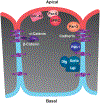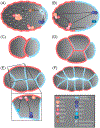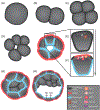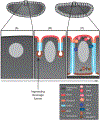Origin and development of primary animal epithelia
- PMID: 38009581
- PMCID: PMC11164562
- DOI: 10.1002/bies.202300150
Origin and development of primary animal epithelia
Abstract
Epithelia are the first organized tissues that appear during development. In many animal embryos, early divisions give rise to a polarized monolayer, the primary epithelium, rather than a random aggregate of cells. Here, we review the mechanisms by which cells organize into primary epithelia in various developmental contexts. We discuss how cells acquire polarity while undergoing early divisions. We describe cases where oriented divisions constrain cell arrangement to monolayers including organization on top of yolk surfaces. We finally discuss how epithelia emerge in embryos from animals that branched early during evolution and provide examples of epithelia-like arrangements encountered in single-celled eukaryotes. Although divergent and context-dependent mechanisms give rise to primary epithelia, here we trace the unifying principles underlying their formation.
Keywords: blastocoel; epithelialization; lumen; monolayer; polarity; self-organization.
© 2023 Wiley Periodicals LLC.
Conflict of interest statement
CONFLICT OF INTEREST STATEMENT
The authors declare no conflicts of interest.
Figures










Similar articles
-
Lateral cell polarization drives organization of epithelia in sea anemone embryos and embryonic cell aggregates.Proc Natl Acad Sci U S A. 2024 Nov 12;121(46):e2408763121. doi: 10.1073/pnas.2408763121. Epub 2024 Oct 29. Proc Natl Acad Sci U S A. 2024. PMID: 39471210 Free PMC article.
-
Cell polarity oscillations in mitotic epithelia.Curr Opin Genet Dev. 2019 Aug;57:47-53. doi: 10.1016/j.gde.2019.07.007. Epub 2019 Aug 26. Curr Opin Genet Dev. 2019. PMID: 31465986 Review.
-
Cell-Cycle-Coupled Oscillations in Apical Polarity and Intercellular Contact Maintain Order in Embryonic Epithelia.Curr Biol. 2017 May 8;27(9):1381-1386. doi: 10.1016/j.cub.2017.03.064. Epub 2017 Apr 27. Curr Biol. 2017. PMID: 28457868
-
Cell flow and tissue polarity patterns.Curr Opin Genet Dev. 2011 Dec;21(6):747-52. doi: 10.1016/j.gde.2011.08.010. Epub 2011 Sep 28. Curr Opin Genet Dev. 2011. PMID: 21955795 Review.
-
Prkci is required for a non-autonomous signal that coordinates cell polarity during cavitation.Dev Biol. 2016 Aug 1;416(1):82-97. doi: 10.1016/j.ydbio.2016.06.002. Epub 2016 Jun 14. Dev Biol. 2016. PMID: 27312576 Free PMC article.
Cited by
-
Lateral cell polarization drives organization of epithelia in sea anemone embryos and embryonic cell aggregates.bioRxiv [Preprint]. 2024 Apr 10:2024.04.07.588493. doi: 10.1101/2024.04.07.588493. bioRxiv. 2024. Update in: Proc Natl Acad Sci U S A. 2024 Nov 12;121(46):e2408763121. doi: 10.1073/pnas.2408763121. PMID: 38645007 Free PMC article. Updated. Preprint.
-
Lateral cell polarization drives organization of epithelia in sea anemone embryos and embryonic cell aggregates.Proc Natl Acad Sci U S A. 2024 Nov 12;121(46):e2408763121. doi: 10.1073/pnas.2408763121. Epub 2024 Oct 29. Proc Natl Acad Sci U S A. 2024. PMID: 39471210 Free PMC article.
-
Depletion of a neural cell adhesion molecule disrupts both epithelial and germ layer identity in sea anemone embryos.bioRxiv [Preprint]. 2025 Aug 4:2025.08.03.668367. doi: 10.1101/2025.08.03.668367. bioRxiv. 2025. PMID: 40799585 Free PMC article. Preprint.
References
-
- Brusca GJ, Brusca RC, & Gilbert SF (1997). Characteristics of metazoan development. In: (Gilbert AM, S.F. and Raunio Ed.), Embryology: Constructing the Organism (pp. 3–19).
Publication types
MeSH terms
Grants and funding
LinkOut - more resources
Full Text Sources

